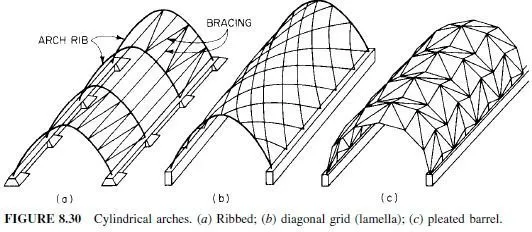The design of cold-formed steel differs from heavier construction in that elements of members typically have large width-to-thickness (w/ t) ratios and are thus subject to local buckling.
Figure 10.2 illustrates local buckling in beams and columns. Flat elements in compression that have both edges parallel to the direction of stress stiffened by a web, flange, lip or stiffener are referred to as stiffened elements. Examples in Fig. 10.2 include the top flange of the channel and the flanges of the I-cross section column.
To account for the effect of local buckling in design, the concept of effective width is employed for elements in compression. The background for this concept can be explained as follows.
Unlike a column, a plate does not usually attain its maximum load carrying capacity at the buckling load, but usually shows significant post buckling strength. This behavior is illustrated in Fig. 10.3, where longitudinal and transverse bars represent a plate that is simply supported along all edges. As the uniformly distributed end load is gradually increased, the longitudinal bars are equally stressed and reach their buckling load simultaneously. However, as the longitudinal bars buckle, the transverse bars develop tension in restraining the lateral deflection of the longitudinal bars. Thus, the longitudinal bars do not collapse when they reach their buckling load but are able to carry additional load because of the transverse restraint. The longitudinal bars nearest the center can deflect more than the bars near the edge, and therefore, the edge bars carry higher loads after buckling than do the center bars.
The post buckling behavior of a simply supported plate is similar to that of the grid model. However, the ability of a plate to resist shear strains that develop during buckling also contributes to its post buckling strength. Although the grid shown in Fig. 10.3a buckled into only one longitudinal half-wave, a longer plate may buckle into several waves as illustrated in Figs. 10.2 and 10.3b. For long plates, the half-wave length approaches the width b.
After a simply supported plate buckles, the compressive stress will vary from a maximum near the supported edges to a minimum at the mid-width of the plate as shown by line 1 of


Fig. 10.3c. As the load is increased the edge stresses will increase, but the stress in the midwidth of the plate may decrease slightly. The maximum load is reached and collapse is initiated when the edge stress reaches the yield stress a condition indicated by line 2 of Fig. 10.3c.
The post buckling strength of a plate element can be considered by assuming that after buckling, the total load is carried by strips adjacent to the supported edges which are at a uniform stress equal to the actual maximum edge stress. These strips are indicated by the dashed lines in Fig. 10.3c. The total width of the strips, which represents the effective width of the element b, is defined so that the product of b and the maximum edge stress equals the actual stresses integrated over the entire width. The effective width decreases as the applied stress increases. At maximum load, the stress on the effective width is the yield stress.
Thus, an element with a small enough w/ t will be able to reach the yield point and will be fully effective. Elements with larger ratios will have an effective width that is less than the full width, and that reduced width will be used in section property calculations.
The behavior of elements with other edge-support conditions is generally similar to that discussed above. However, an element supported along only one edge will develop only one effective strip.
Equations for calculating effective widths of elements are given in subsequent articles based on the AISI Specification. These equations are based on theoretical elastic buckling theory but modified to reflect the results of extensive physical testing.




